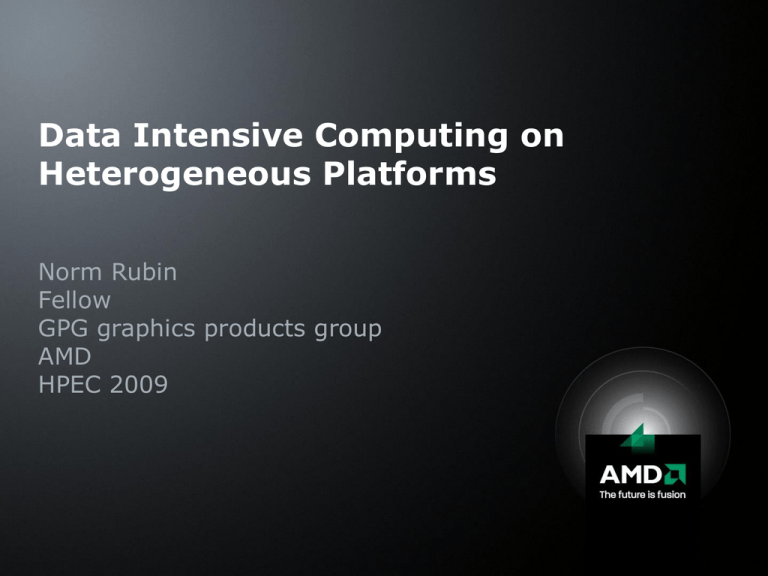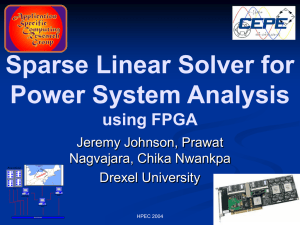
Data Intensive Computing on
Heterogeneous Platforms
Norm Rubin
Fellow
GPG graphics products group
AMD
HPEC 2009
What might we see in future platforms?
Multi-core implies reprogramming so all kinds of new
architectures are possible
The traditional view of more performance per year, based
on clock changes is over
New approaches will change our view of computing
platforms
Compute is about to change radically
The drivers for compute
1. New more natural user interfaces
2. Search (e.g., finding things in images) Massive data
3. Search over time changing data (e.g., live video)
Massive data
4. Machine learning (starting with simple models)
Massive data
5. Standard compute tasks
Data intensive covers 2,3, and 4
‹#› HPEC Sept 2009
Massive Data and machine learning
Data-driven models become tractable and usable
Less need for analytical models
Less need for heuristics
Real-time connectivity enables continuous model
refinement
Poor model is an acceptable starting point
Classification accuracy improves over time
‹#› HPEC Sept 2009
Simple Models
Google demonstrated the value of applying massive
amounts of computation to language translation in the
2005 NIST machine translation competition.
They won all four categories of the competition
translating Arabic to English and Chinese to English.
Purely statistical approach
multilingual United Nations documents comprising over
200 billion words, as well as English-language
documents comprising over one trillion words.
No one in their machine translation group knew either
Chinese or Arabic.
Google tops translation ranking. News@Nature, Nov. 6, 2006.
‹#› HPEC Sept 2009
How Technology May Soon "Read" Your Mind
Establish the correspondence between a simple cognitive
state (such as the thought of a hammer) and the
underlying brain activity.
Use machine learning techniques to identify the neural
pattern of brain activity underlying various thought
processes. MRI scanner generates data
Data base of responses of individuals
Using fMRI Brain Activation to Identify Cognitive States Associated with Perception
of Tools and Dwellings
S.V. Shinkareva, R.A. Mason, V.L. Malave, W. Wang, T. M. Mitchel, and M. A. Just,
PLoS ONE 3(1): e1394. doi:10.1371/journal.pone.0001394, January 2, 2008.
‹#› HPEC Sept 2009
New ways to program graphics
A domain expert (the programmer), 3 cameras, silhouette
extraction and a large data base of human motions
Use 3D movement as a programming language
L. Ren, G. Shakhnarovich, J. K. Hodgins, H. Pfister, and P. Viola. Learning
silhouette features for control of human motion. ACM Transactions on
Graphics, 24(4), October 2005.
‹#› HPEC Sept 2009
‹#› HPEC Sept 2009
How will GPU/CPU change to meet big data?
Current machine models are two separate devices
GPU – a graphics thing, maybe also a data parallel
accelerator, good for lots of data, small programs
CPU – a serial processor, maybe capable of task
parallelism, good for limited data, big programs
CPU strength is single thread performance
(latency machine)
GPU strength is massive thread performance
(throughput machine)
‹#› HPEC Sept 2009
GPU compared with CPU
GPU
CPU
Great float
Great control flow
Great bandwidth
Lots of existing code
High performance without fixed Locked into an legacy isa
isa, lots of room for innovation,
Very good at reuse, real
without breaking code
caches
different to program
But
But
Limited scratchpad memory in
place of a cache
‹#› HPEC Sept 2009
Limited ability to scale with
cores
Some limitations of today's GPU
general cross thread communication
task switching, task parallel problems
nested parallelism
dynamic parallelism
very expensive to move data between GPU/CPU
programmer controlled small scratch pad memory
‹#› HPEC Sept 2009
The 3C view of the future, (c-cubed?)
We are in a time of architectural change much like the
switch from mainframes to microprocessors
abundant content, connections, compute
Slash dot http://science.slashdot.org/article.pl?sid=09/08/20/1233258
NASA Probe Blasts 461 Gigabytes of Moon Data Daily
On its current space scouting mission, NASA's Lunar Reconnaissance Orbiter (LRO) is
using a pumped up communications device to deliver 461 gigabytes of data and images
per day, at a rate of up to 100 Mbps. As the first high data rate K-band transmitter to
fly on a NASA spacecraft, the 13-inch-long tube, called a Traveling Wave Tube
Amplifier, is making it possible for NASA scientists to receive massive amounts of
images and data about the moon's surface and environment… It kills me that the
moon has better bandwidth than my house.
‹#› HPEC Sept 2009
Software Challenge
Most of the successful parallel applications seem to have
dedicated languages (DirectX®11/map-reduce/sawzsall)
for limited domains
Small programs can build interesting applications,
Programmers are not super experts in the hardware
Programs survive machine generations
Can we replicate this success in other domains?
‹#› HPEC Sept 2009
Can we get performance with high level
languages?
CUDA and OpenCL are good languages in the hands of
experts but they are still too low level
We need high level programming models that express
computations over data
One possible model is “MapReduce”
Map part selects interesting data
Reduce part combines the interesting data
‹#› HPEC Sept 2009
MapReduce
Map: for each input in parallel
if the input is interesting – output a key and a value,
values might be compound structures
Sort based on the keys
Reduce: in parallel for each key
for each value with the same key, combine
‹#› HPEC Sept 2009
Observations on MapReduce
Developers only write a small part of the program, rest of
the code comes from libraries
No race conditions are possible
No error reporting (just keep going)
Can view the program as serial (per input)
No developer knows the number of processors
Not like pthreads
Hard part is reductions, but it appears that there are only
a few that are common, so maybe they can be prebuilt
‹#› HPEC Sept 2009
Notice nested parallelism in MapReduce
For each key (in parallel)
do a parallel reduction (also parallel)
One key may have lots of values, a second key might
have a few (work stealing? Dynamic parallelism?)
‹#› HPEC Sept 2009
K means clustering (representative algorithm)
Given N objects each with A attributes and K possible
cluster centers
Map:
for each object find the distance to each center
Classify the object into a cluster, based on min distance
Key is the cluster, data is the object
Reduce: for all objects in the same cluster,
find the new cluster centers
Repeat till no object changes clusters
‹#› HPEC Sept 2009
K means demo
‹#› HPEC Sept 2009
K means performance experimental data
CPU 4 - core i7 processor
GPU (2 NV 260 mid range GPU’s)
GPU programmed in CUDA
CPU programming in TBBU
(joint work with Balaji Dhanasekaran,
U of Virginia)
AMD has announced a new higher performance GPU card (58xx
series), which supports the industry standard language OpenCL.
Performance numbers using OpenCL on AMD hardware
Will be posted at http://developer.amd.com/Pages/default.aspx
‹#› HPEC Sept 2009
Performance
4 million objects, 2 attributes, 100 clusters
50 iterations
Map
Reduce
Time (sec)
2GPU
2GPU
.81
2GPU
4CPU
1.29
1GPU
1GPU
1.54
1GPU
4CPU
1.71
4CPU
4CPU
33.11
1CPU
1CPU
157.34
4 CPU
1CPU
40.9
194
21.5
102
1
4.75
1
Measured performance for other sizes shows similar results, better for larger attributes, objects
‹#› HPEC Sept 2009
K-means
Do most of the work on the GPU, but do some of the
reductions on the CPU if you have enough idle cores.
Preliminary numbers suggest GPU can solve this very
well.
Can we develop software that automatically adjusts for
this, or do programmers have to write variant
algorithms?
‹#› HPEC Sept 2009
Disclaimer and Attribution
DISCLAIMER
The information presented in this document is for informational purposes only and may contain
technical inaccuracies, omissions and typographical errors.
AMD MAKES NO REPRESENTATIONS OR WARRANTIES WITH RESPECT TO THE CONTENTS
HEREOF AND ASSUMES NO RESPONSIBILITY FOR ANY INACCURACIES, ERRORS OR OMISSIONS
THAT MAY APPEAR IN THIS INFORMATION.
AMD SPECIFICALLY DISCLAIMS ANY IMPLIED WARRANTIES OF MERCHANTABILITY OR FITNESS
FOR ANY PARTICULAR PURPOSE. IN NO EVENT WILL AMD BE LIABLE TO ANY PERSON FOR ANY
DIRECT, INDIRECT, SPECIAL OR OTHER CONSEQUENTIAL DAMAGES ARISING FROM THE USE OF
ANY INFORMATION CONTAINED HEREIN, EVEN IF AMD IS EXPRESSLY ADVISED OF THE
POSSIBILITY OF SUCH DAMAGES.
ATTRIBUTION
© 2009 Advanced Micro Devices, Inc. All rights reserved. AMD, the AMD Arrow logo, ATI, the
ATI logo, CrossFireX, PowerPlay and Radeon and combinations thereof are trademarks of
Advanced Micro Devices, Inc. Other names are for informational purposes only and may be
trademarks of their respective owners.
‹#› HPEC Sept 2009
Questions?
‹#› HPEC Sept 2009



